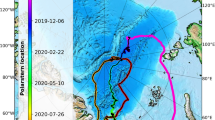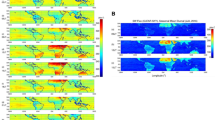Summary
The purpose of this study is to better understand the dynamical and microphysical processes within Arctic clouds, which occurred in April 1998 over the Surface Heat Budget of the Arctic Ocean (SHEBA) ship during the First ISCCP (International Satellite Cloud Climatology Project) Regional Experiment Arctic Cloud Experiment (FIRE.ACE). The observations from the four cases in the present study were collected by instruments mounted onboard the National Research Council (NRC) Convair, as well as, the National Oceanic and Atmospheric Administration (NOAA) Advanced Very High Resolution Radiometer (AVHRR) satellite, the SHEBA surface based NOAA Doppler radar (35 GHz, Ka-Band), and the NOAA depolarization lidar (0.523 µm) measurements. The aircraft observations were collected at 32 Hz (3-m scale). The Meteorological Services of Canada (MSC) lidar (1.064 µm) was operated onboard the Convair-580. The AVHRR observations, representing a 5-km horizontal resolution, were used to estimate particle size, phase, and optical thickness. Constant altitude flight legs were made at about 100 m over the ocean surface. Vertical air velocity (w), reflectivity and Doppler velocity, and backscatter and depolarization ratio values were used to define the size of the important dynamical structures. Ice crystal number concentration (Ni), ice water content (IWC), droplet number concentration (Nd), liquid water content (LWC) and characteristic particle size and shape were summarized for each case. The effective radius (reff) values for liquid clouds obtained from in-situ and AVHRR observations were found comparable. The large variability in IWC can be due to undetected ice crystals at small size ranges. Mixed phased conditions in the AVHRR retrievals complicated the comparisons with in-situ data. Ni was found to be directly related to the history of the air-parcel dynamics e.g., w. The variability and differences in the parameters obtained from various platforms can be attributed to their instrumental capabilities, resolution, as well as the cloud development.
Similar content being viewed by others
Author information
Authors and Affiliations
Rights and permissions
About this article
Cite this article
Gultepe, I., Isaac, G., Key, J. et al. Dynamical and microphysical characteristics of Arctic clouds using integrated observations collected over SHEBA during the April 1998 FIRE.ACE flights of the Canadian Convair. Meteorol Atmos Phys 85, 235–263 (2004). https://doi.org/10.1007/s00703-003-0009-z
Received:
Revised:
Accepted:
Published:
Issue Date:
DOI: https://doi.org/10.1007/s00703-003-0009-z




